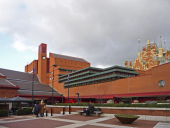
London, known primarily for the iconic River Thames, holds a lesser-known secret: a vast network of waterways spanning 640 kilometers. These hidden rivers, once integral to the city's history,
are now at the center of a remarkable movement aimed at restoring these "blue corridors" to their former glory.
Historical maps reveal a web of rivers and brooks that once provided food sources and recreational opportunities, traversing the city for centuries. However, as London experienced rapid growth, these waterways gradually faded from public consciousness. Many were enclosed by walls, transformed into polluted backwaters, or simply buried beneath bustling streets.
Nevertheless, the imprint of these "secret" rivers remains embedded in London's geography. Neighborhoods like Marylebone, Bayswater, Knightsbridge, Westbourne, Holborn, Deptford, and Wandsworth derived their names from the waterways that once flowed through them. Even Fleet Street, once the hub of Britain's newspapers, still conceals the River Fleet beneath its surface.
According to Will Oliver, a development manager at Thames21, a charity involved in over 40 river restoration projects, "London should really be one massive wetland – a salt marsh on an estuary." Thanks to the efforts of Thames21 and other organizations, buried rivers have resurfaced, while others are being rewilded, leading to improved lives, a healthier environment, and a significant boost for nature.
One inspiring project is the revitalization of the Old Lea river by the Wildlife Gardeners of Haggerston, located in Hackney Marshes, East London. Amidst the backdrop of bustling streets, a vast park, and numerous football pitches, a line of trees conceals this ancient river, offering a tranquil slice of rural England within the city's confines. Remarkably, egrets and kingfishers can be spotted within minutes of arriving, showcasing the positive impact of these restoration efforts.
The Haggerston volunteer group, led by co-founder Esther Adelman, focuses on enhancing the river flow and eliminating invasive habitats. Fallen trees strategically placed as partial river barriers, known as berms, create a diverse range of habitats, including gravel areas where fish can spawn. Adelman describes their work as imitating natural processes, akin to "human beavers."
Gideon Corby, another volunteer from the Old Lea project and habitat manager at the nearby Kingsland Basin Nature Reserve, highlights the role of reeds in purifying the river by absorbing pollutants through their roots.
With a mix of hope and quiet confidence, Adelman shares her vision: "We hope eventually the Lea will become home to otters."
In addition to the efforts of volunteer groups, organizations like the South East Rivers Trust (SERT) have trained citizen science volunteers to survey eels as part of the Thames Catchment Community Eels Project. This initiative involved counting eels in secluded backwater rivers such as the Mole, Kennet, Pang, Ravensbourne, and Brent, and collaborating with schools to deliver workshops, riverbank walks, and interactive online games.
Through these surveys, SERT volunteers have identified numerous barriers hindering eel movement, prompting strategies to protect this endangered species. Similarly, the River Hogsmill Connectivity Project successfully removed 17 out of 18 obstacles along this west London waterway, facilitating fish migration.
The restoration and conservation of London's lost rivers demonstrate a growing commitment to reestablishing the city's natural heritage. These endeavors not only revive forgotten waterways but also provide valuable habitats, cleaner environments, and opportunities for the public to engage with nature.


































